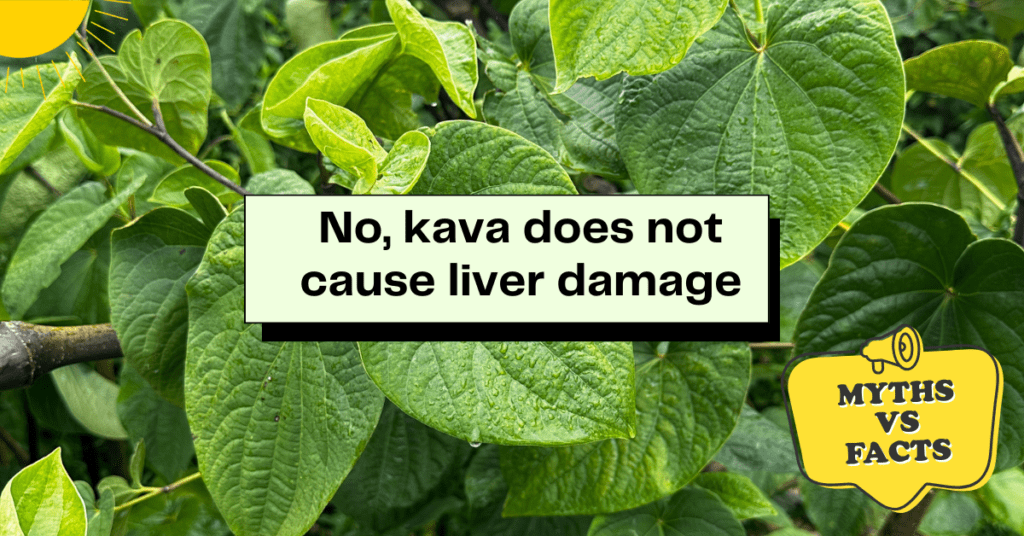I. Traditional kava consumption versus modern perceptions
In the contemporary United States, when people think of kava, they often think of tinctures, pills, or extracts. However, it’s crucial to understand that kava’s origins and primary form of consumption in the Pacific Islands is as a traditional beverage. Derived from the Piper Methysticum plant, kava has been a cherished drink for centuries, integral to the Pacific Islands’ cultural ceremonies and medicinal practices. However, despite its long tradition, kava myths are floating around questioning its safety.

II. The historical context of kava consumption
Pacific Islanders have revered kava for its therapeutic properties and social significance for millennia. While modern adaptations have expanded its forms to include concentrates, extracts, and mints, the traditional medium grind kava root remains the most authentic representation of this historic beverage. In its genuine form, kava is celebrated for promoting relaxation, alleviating anxiety, enhancing mood, and facilitating muscle relaxation.
III. The emergence of liver damage concerns
The late 1990s marked a concerning period for kava, as reports and myths from Europe and the USA began associating kava-containing products with liver issues. These incidents prompted global regulations, notably a ban on kava products in some European countries. We covered the story in depth on our TikTok channel @kavahana here:
IV. The World Health Organization’s clarification
A recent comprehensive study by the World Health Organization (WHO) titled “Kava: A Review of the Safety of Traditional and Recreational Beverage Consumption” critically examined the previously raised concerns and myths about kava’s potential liver toxicity. Their exhaustive research led to a crucial insight: no scientific evidence suggests that kava causes liver damage, debunking what has been a long-standing myth.
We’ve shared the full PDF to the World Health Organization paper on our site kavahana.com
V. The role of the council for responsible nutrition (CRN) in shaping perceptions
The influence of entities such as CRN, a prominent trade association, has been significant in framing perceptions around kava. In 2014, CRN proposed specific labeling warnings for kava products, emphasizing potential liver injury risks. However, even within these recommendations, an essential caveat was highlighted: there is a lack of evidence establishing a causal relationship between kava consumption and liver damage. Such cautious yet ambiguous guidelines might inadvertently perpetuate misconceptions.
VI. Conclusion
In synthesizing the available research, particularly the recent findings from the WHO, it becomes evident that the myths surrounding kava and its alleged hepatotoxic effects need urgent reevaluation. Modern perceptions, shaped by selective presentations and outdated reports, must be realigned with current, rigorous, and evidence-based conclusions. To unequivocally address the main concern, there is no scientific evidence to suggest that kava causes liver damage, and any such belief is, in fact, a myth.
* Please note that the majority of kava research pertains to kava extracts, which often undergo significant processing and may contain additional ingredients and fillers that can influence their efficacy. It is crucial to consider this distinction when reading about kava studies. To draw an analogy, enjoying natural kava as a beverage can be likened to experiencing a freshly brewed cappuccino, whereas kava extracts are akin in functionality to a caffeine pill. Both forms have their unique benefits and can cater to different preferences and needs. While it’s helpful to understand research on kava extracts, please view it critically and remember that natural kava offers a uniquely holistic experience.
Sources:
Updated WHO Study: “Kava: a review of the safety of traditional and recreational beverage consumption”. https://openknowledge.fao.org/server/api/core/bitstreams/f97fbe5f-244e-4301-be2a-03ac39ef630b/content
WHO Study: “Assessment of the risk of hepatotoxicity with kava products”. https://iris.who.int/bitstream/handle/10665/43630/9789241595261_eng.pdf
“FAERS Kava Adverse Reports.” September, 2022. Google Docs. Accessed November 17, 2022. https://docs.google.com/spreadsheets/d/1WP-51afXDK08VPwiotfJLQR-KIXtR_Hweky-3T_WMc0/edit?usp=sharing.
“About CRN.” n.d. Accessed November 17, 2022. https://www.crnusa.org/about-crn.
CRN. 2014. “CRN Safety Considerations for Dosage Recommendations and Labeling.” Council for Responsible Nutrition. https://crnusa.org/sites/default/files/pdfs/CRN-Safety-Considerations-Vol_Dosage_Labeling-Revpost2014.pdf.
Gruenwald, Joerg, Cordula Mueller, and Skrabal Juergen. 2003. “In-Depth Investigation Into EU Member States Market Restrictions On Kava Products.” Centre for the Development of Entreprise.https://www.taxtyranny.ca/images/HTML/Health-Regulatory-History/Canada/Articles/kavareport.pdf
Schmidt, M., and Harsewinkel. 2002. “Is Kava Really Hepatotoxic? An Analysis of the Known Data on Adverse Effects of Kava Preparations on the Liver.” http://www.fijihosting.com/dload/is_kava_really_hepatotoxic.pdf
Tags: kava liver damage myth, kava kava and liver damage, kava kava liver toxicity, kava kava liver damage myth, does kava kava cause liver damage, can kava cause liver damage







